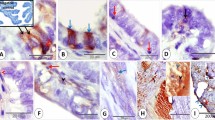Summary
Estradiol is demonstrated to induce histidine decarboxylase, and histamine is shown to activate adenylate cyclase in rat uterus. Histamine and cyclic 3′,5′-AMP mimic the effects of estradiol in that they enhance RNA synthesis, induce glycolytic enzymes and uterus imbibition. The data suggest that estradiol enhances by induction of histidine decarboxylase the formation of histamine, the latter activates adenylate cyclase providing accumulation of cyclic 3′,5′-AMP, which, probably, induces glycolytic enzymes through phosphorylation of chromatin proteins, and mediates other estradiol effects. The chain of successively acting enzymes and mediators constitutes, obviously, a cascade amplifying estradiol action. Since histamine is known to act as an intercellular mediator, attempts were made to find out the distribution of estradiol histamine and cyclic 3′,5′-AMP among uterus cells. Autoradiography has shown that [3H]-estradiol is bound by the nuclei of myometrium cells, [3H]-histamine was found above the cytoplasm of these cells, [3H]-cyclic 3′,5′-AMP is selectively bound by the cells of capillary endothelium of the uterus. The estradiol mediators seem to spread effect of hormone on cells of different types which form together a kind of multicellular functional system.
Similar content being viewed by others
References
Hechter, O., Yoshinaga, K., Halherston, J. D. K. and Birchall, 1967. Arch. Bioch. Biophys., 122, 449–465.
Singhal, R. L., 1973. Adv. in Pharmacol. and Chemother., New-York-London, 11, 99–150.
Szego, C., 1965. Fed. Proc., 6, 1343–1352.
Salganik, R. I., Bersimbaev, R. I. Argutinskaya, S. V., Kiseleva, E. V., Khristolyubova, N. B. and Deribas, V. I., 1976. Mol. Cell. Biochem. 12, 181–191.
Hamilton, T. H., Widnell, C. C. and Tata, Y. R., 1968. J. Biol; Chem., 243, 408–417.
Singhal, R. L. and Valadares, J. R. E., 1970. Amer. J. Physiol., 218, 321–327.
Valadares, J. R. E., Singhal, R. L. and Parulecar, M. R., 1968. Science, 159, 990–991.
Schayer, R. W., Rothschild, Z. and Bizony, P., 1959. Amer. J. Physiol., 196, 295–298.
Krishna, Y., Weiss, B. and Brody, B. B., 1968. J. Pharm and Exp. Ther., 163, 379–385.
Dishe, L. and Rosenfeld, E., 1957. Bioch. Bioph. Acta. 23, 669.
Clarc, R. B. and Perkins, G. P., 1971. Proc. Natl. Acad. Sci. USA, 68, 2757–2760.
Lindl, T. and Cramer, H., 1974. Biochim. Biophys. Acta, 343, 182–191.
Palmer, G. C. 1971. Biochim. Biophys. Acta, 252, 561–566.
Cohen, M. E. and Kleinsmith, L. J., 1976. Biochim. Biophys. Acta, 435, 159–166.
Goodman, D. B. R., Bloom, F. E., Battenberg, E. R., Rasmussen, H. and Davis, W. L., 1975. Science, 188, 1023–1025.
Stumpf, W. E., 1968, Endocrinology, 83, 777.
Author information
Authors and Affiliations
Rights and permissions
About this article
Cite this article
Salganik, R.I., Pankova, T.G., Deribas, V.I. et al. Multistage functional system amplifying and spreading the effect of estradiol in rat uterus. Mol Cell Biochem 29, 183–188 (1980). https://doi.org/10.1007/BF00420289
Received:
Issue Date:
DOI: https://doi.org/10.1007/BF00420289




